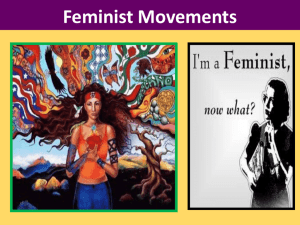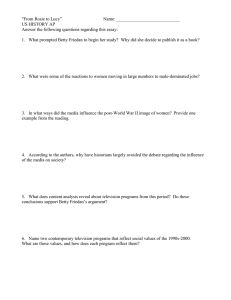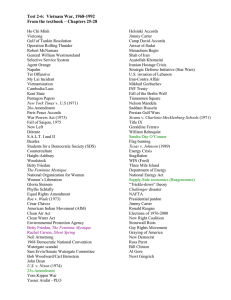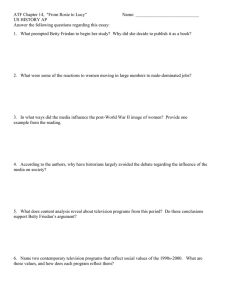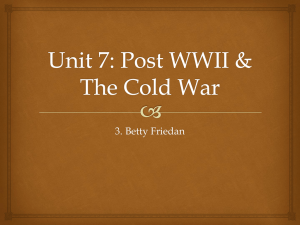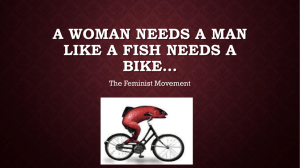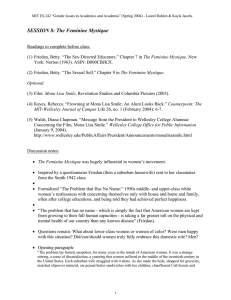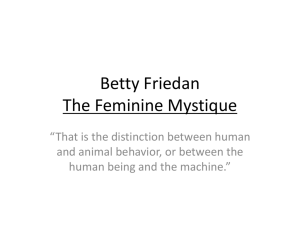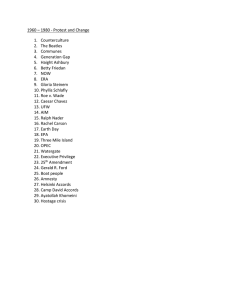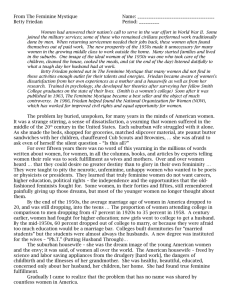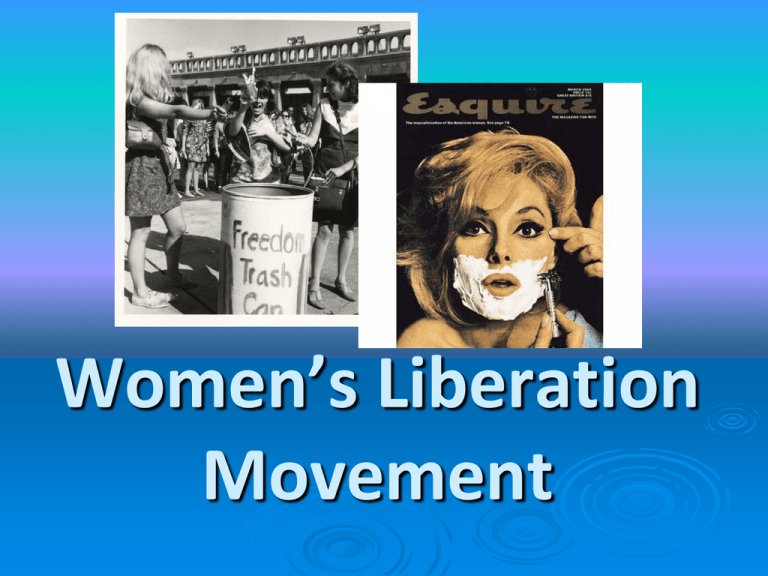
Women’s Liberation
Movement
What were they fighting for?
Women wanted equal rights to men legally,
socially, and economically.
Though women were allowed to work, they
were getting paid meager amounts
compared to men and were restricted in
their available career paths.
Prior to the 1960s, young single women
were expected to get married, have
children, and take care of their families.
The movement focused on changing the idea
that women could only be mothers – women
could and should be anything they wanted to
be, just like men had the right to.
The civil rights movement coincided with the
women’s movement. African – American
women were an especially ignored faction of
society.
Timeline
1960: The Food and Drug Administration
approves birth control pills.
1963: Betty Friedan releases The Feminine
Mystique laying the ground work for the
feminist movement, the same year as the
March to Washington.
Betty Friedan
Author of The Feminine
Mystique and co – founder
of the National Organization
for Women (NOW)
She was a staunch
supporter of abortion laws
and a supporter of the
Equal Rights Amendment to
the Constitution
After her death, many
sources claimed she was
infamously abrasive in her
popular obituary in the NY
Times
The Feminine Mystique
Excerpt from the text on “The Problem That Has No
Name”:
"The problem lay buried, unspoken, for many years in
the minds of American women. It was a strange
stirring, a sense of dissatisfaction, a yearning [that
is, a longing] that women suffered in the middle of
the 20th century in the United States. Each
suburban wife struggled with it alone. As she made
the beds, shopped for groceries … she was afraid to
ask even of herself the silent question — 'Is this
all?’’
Gloria Steinem
One of the most famous
second - wave feminists
of her time, credited for
gaining awareness of the
rights issue
Journalist and activist for
The New York magazine in
the 1960s
Fought for Equal Rights
Amendment to the
Constitution alongside
Friedan as well as avidly
supporting same – sex
marriage
Quotes by Steinem
“I have yet to hear a man ask for advice on how to
combine marriage and a career.”
“No man can call himself liberal, or radical, or even
a conservative advocate of fair play, if his work
depends in any way on the unpaid or underpaid
labor of women at home, or in the office.”
“We've begun to raise daughters more like sons...
but few have the courage to raise our sons more
like our daughters.”
1966: Twenty – eight women found the
National Organization for Women, including
author Betty Friedan.
1968: First public speak-out against abortion
laws are held in New York. The same year
women protest the Miss America Beauty
Pageant in Atlantic City.
1969: Redstockings, a radial feminist group, is
organized.
1970: President Richard Nixon vetoes the
Comprehensive Child Development Act,
which would have established federally
funded childcare centers.
1973: The Supreme Court strikes down many
state abortion laws in the case Roe v. Wade.
Now?
Think…
Can men be feminists also or is the
movement limited to women only?
Does the term “feminist” still apply today?
In some ways, the women’s liberation
movement has not ended. Why can this be
considered so?
“The Women’s Liberation Movement
and Public Schools”
(Discover Magazine online)
http://blogs.discovermagazine.com/cosmicv
ariance/2008/04/07/the-womens-liberationmovement-and-public-schools/

